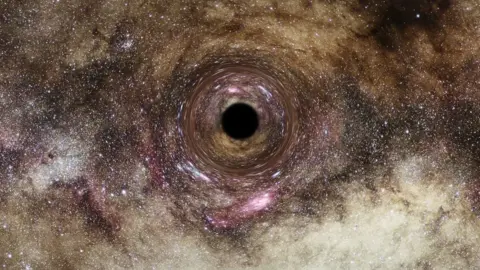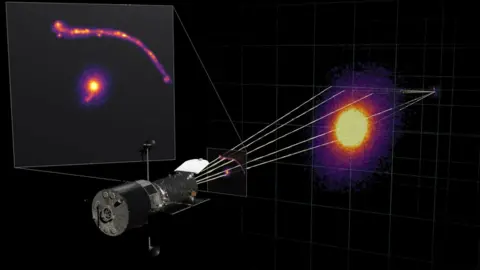'Ultramassive' black hole discovered by Durham astronomers
 ESA/Hubble/Digitized Sky Survey/Nick Risinger
ESA/Hubble/Digitized Sky Survey/Nick RisingerAstronomers say they have found one of the universe's largest black holes to date using a new technique.
Scientists at Durham University discovered the "ultramassive" black hole by observing its pull on passing light, called gravitational lensing.
Dr James Nightingale who led the study said even he struggled to "comprehend how big this thing is".
Their findings have been published in the journal Monthly Notices of the Royal Astronomical Society.
The academics said the black hole was 30 billion times the size of our Sun and was the first to be measured using gravitational lensing.
 Durham University
Durham UniversityDr Nightingale told BBC Radio Newcastle: "Even as an astronomer, I find it hard to comprehend how big this thing is.
"If you look at the night sky and count up all the stars and planets you can see and put them in a single point, it would be a fraction of a percent the size of this black hole.
"This black hole is bigger than the majority of galaxies in the universe."
He said the discovery "pushes our understanding of astronomy to the limits", adding: "How do you form a black hole this big in just 13 billions years of the universe's existence?"

What is a black hole?
- A black hole is a region of space where matter has collapsed in on itself.
- The gravitational pull is so strong that nothing, not even light, can escape.
- Black holes will emerge from the explosive demise of certain large stars.
- But some are truly huge and are billions of times the mass of our Sun.
- How these monsters - found at galaxy centres - formed is unknown.
- But it is clear they energise the galaxy and will influence its evolution.
Source: Nasa

The discovery began in 2004 when Durham University Professor Alastair Edge noticed a giant arc of light when reviewing images of a galaxy survey.
The study, which also involved Germany's Max Planck Institute, used extremely high-resolution images from NASA's Hubble telescope and the university's DiRAC COSMA8 supercomputer facilities to explore further and confirm the black hole's existence.
Dr Nightingale said as light travels through the universe it "appears to be pulled towards the mass of nearby objects".
"We found this very special light ray that travelled extremely close to this black hole," he said, adding: "Roughly 40 billion times the distance of the Sun to the Earth is how close it was which in astronomical terms is a very small amount."
Dr Nightingale said the use of gravitational lensing could "let us detect many more black holes beyond our local universe and reveal how these exotic objects evolved further back in cosmic time".

Follow BBC North East & Cumbria on Twitter, Facebook and Instagram. Send your story ideas to [email protected].
